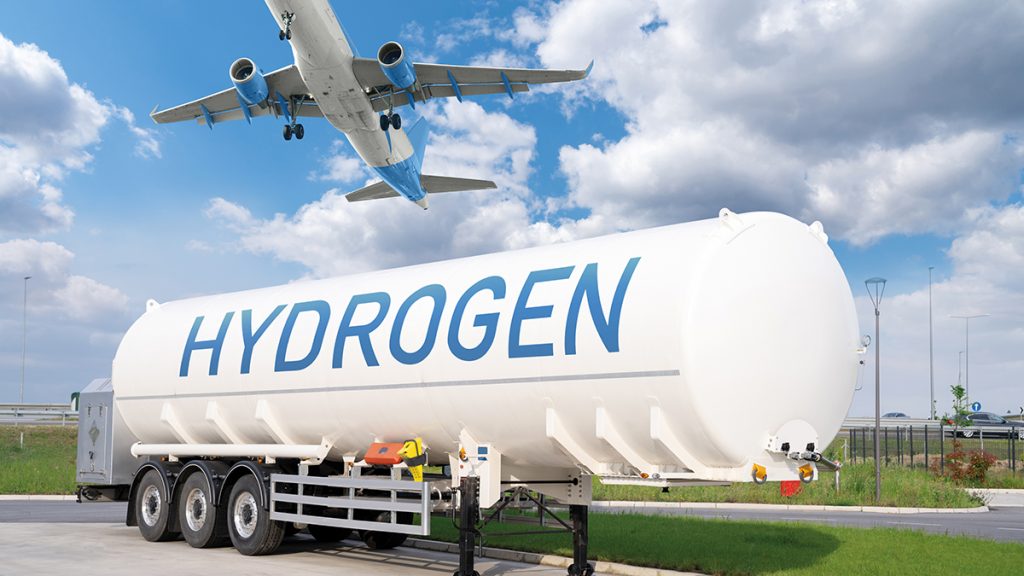Cranfield’s Hydrogen Integration Incubator (CH2i)
The ‘third aviation revolution’ — the development of a sustainable aviation infrastructure that protects both the environment and economic growth — is an essential and urgent ambition. The UK’s net-zero aviation emissions by 2050 target is beginning to feel imminent.
Once the outsider in the race to deliver zero-carbon flight, hydrogen has become the frontrunner as the middle to long-term solution. Just as automotive manufacturers have become market leaders from investing early in electric vehicles, aviation businesses now have the opportunity to establish a lead in hydrogen. The kind of lead and experience that will be difficult for competitors to catch up with.
Cranfield Hydrogen Integration Incubator
Work on delivering hydrogen-powered aviation is being driven forward by the Cranfield Hydrogen Integration Incubator (CH2i), based in and around the University’s own airport facilities, workshops and a new set of hydrogen-focused lab spaces. Partnerships with industry are beginning to define programmes of work at CH2i as a means of unlocking the technology challenges, including hydrogen production technologies, catalysts, materials, structures, storage tanks and both engine and whole aircraft designs: an incubator geared towards rapid innovation in a regulated and safety-focused environment.
No doubt, creating a viable hydrogen ecosystem comes with huge challenges. But the large-scale lab spaces needed for working out the processes, from green production to transportation, storage and use both airside and in aircraft, are in place. Industry players such as Airbus, Heathrow Airport, Marshall, Siemens Energy and Toyota have become involved. All that’s needed now is wider collaboration between research institutions and aviation businesses, manufacturers, airports, airlines and their suppliers to innovate, test and demonstrate the most workable technologies and processes. Joint activity that leads to a robust offering and the development of certification processes and rules to ensure the introduction of hydrogen meets or even improves current safety standards.
CH2i is being developed on the basis of £23 million from Research England’s Research Partnership Investment Fund (UKRPIF) and £46 million from industry partners and academic institutions. The Hydrogen Integration Research Centre will include new labs for advanced materials synthesis and testing and a dedicated innovation area to develop next generation hydrogen pilot plant demonstration, electrolysis, catalyst development and green hydrogen. And alongside this, an Enabling Hydrogen Innovation test area focused on gaseous and liquid hydrogen fuel systems, both storage and propulsion system integration
at mid- and high-technology readiness levels.
Hydrogen tradition
The facilities and ambition of CH2i are rooted in Cranfield’s experience in hydrogen applications research since the early 1990s. Within the last decade, as the limitations of electric and other fuel sources became apparent (the problems around the weight of electric batteries in particular), hydrogen has become an important candidate — the large challenges involved in transforming the industry infrastructure into hydrogen-based rather than a kerosene one are looking increasingly worth taking on, because the benefits for the long-term are so clear.
The change has come about largely due to the European Horizon 2020-funded project ENABLEH2 (ENABLing CryogEnic Hydrogen-Based CO2-free Air Transport), which has provided hard evidence for the case for hydrogen. Findings and the roadmap forward, including the need for the makings of a new regulatory framework, have gained EU approval. Cranfield played a leading role in ENABLEH2, alongside Chalmers University, London South Bank University, Heathrow Airport, GKN Aerospace Safran, the European Hydrogen Association and Arttic. Industry involvement included support from Airbus, IATA, ICAO, International Airlines Group, Mitsubishi Power Systems, Rolls-Royce, Siemens and Total. Cranfield’s contribution to the UK’s Fly Zero programme provided further impetus.
In essence, the research has confirmed the qualities of liquid hydrogen as a zero-carbon emissions fuel, one that would also remove sulphur oxide and soot from the aviation emissions profile. Hydrogen brings a promise of much leaner combustion than any hydrocarbon fuel (fossil, bio or synthetic) delivering ultra-low nitrogen oxide emissions (nitrogen oxides contribute to acid rain and the ‘ozone hole’).
Cryogenic hydrogen tanks
The introduction of a new world of hydrogen flight means a full re-design of aircraft and the fuelling infrastructure of supplies and storage on the ground. While hydrogen gas can be used for short hop flights, longer distance flights will need a higher energy density, meaning the storage on-board of liquid hydrogen. Liquid hydrogen has a higher energy density than conventional aviation fuels and offers a much leaner combustion than any hydrocarbon fuel, as well as ultra-low nitrogen oxide emissions. There are no sulphur oxide or soot emissions or CO2 emissions. There is more flexibility in terms of how the energy is extracted: it can be burnt or used within a fuel cell, meaning there is no need for a combustion process on-board the aircraft. The future viability of liquid hydrogen flight, though, is dependent on safe storage on-board.
In general, the storage, transfer, and combustion of hydrogen requires special care because of its highly explosive nature when mixed with air (oxygen). Made up of tiny molecules, hydrogen is known for its diffusion into any type of material, causing different forms of structural damage to whatever material it might be. Using traditional metals for example, such as steel or aluminium, the hydrogen works its way into the lattice of the metal and causes it to become brittle over time, leading to cracking. And with polymers, using a carbon-fibre and glass-fibre tank with a coating inside, the hydrogen will penetrate through the lining and without additional care to the level of tank emptying and filling, the coating will buckle and ultimately fail.
Storage tanks need to be able to withstand extreme variations in temperature: between -253 degrees centigrade and room temperature. Past studies have shown that -200 degrees centigrade has been a challenge in itself for developing cryogenic tanks that need to be lightweight, moving the parameters to -253 for liquid hydrogen brings a whole new level of problems. Absolute reliability and resilience of the cryogenic tank structure is essential for hydrogen flight of any kind. Given the nature of temperatures involved, an incorrect selection of materials or issues with the cryogenic system would lead to a catastrophic failure. Most importantly in aerospace, the design of tanks needs to involve lightweight materials to minimise overall aircraft weight and fuel demands. Stainless steel tanks might provide safety but are unrealistic in terms of the added tonnage.
Over the past year, the University has been working on developing the most efficient aircraft designs, hydrogen combustion systems and workable materials for next generation fuel tanks. This is part of the Airbus driven project to develop the world’s first commercial hydrogen aircraft by 2035. The streams of research and development, jointly funded by the UK government’s Aerospace Technology Institute (ATI), are based around the company’s new Zero Emission Development Centre (ZEDC) for hydrogen technologies in Filton, Bristol.
In order to use hydrogen as fuel in the skies, there is the need for a design of a type VI cryogenic tank. This involves a new bill of materials and deployment of three levels of safety features — each one of which means exploring new generations of materials. The first level is ensuring the hydrogen is kept at the right temperature; the second that there is the guarantee that even if the energy input and active cooling or other systems fail, the materials being used will keep the liquid hydrogen at a safe temperature and pressure environment for long enough for the aircraft to land and the issues be resolved. The third is that if there is an unforeseen and uncontrollable event, that the fuel or the tank itself can be disposed of safely — and the aircraft still has enough fuel to land.
One type of materials under development is based around a new form of self-healing polymers. To minimise safety concerns, there is the need for a material that is capable of both self-diagnosis and self-healing of damage caused to its structure. A self-healing polymer is particularly effective in repairing minor cracks and avoiding a worsening of the damage. The next critical material for the tank is made up of high performance, lightweight insulators like aerogels: the synthetic porous ultralight materials derived from a gel which retain their form even when the liquid element is replaced with a gas. The nature of the materials makes them the lightest possible material yet created. Finally, a two-dimensional graphene layer is being used to maximise the reduction of hydrogen leaks and to take the mechanical stability of the overall structure to another level.
Extensive work is ongoing at Cranfield around the material development and molecular tuning to achieve the levels of performance needed, as well as the use of different combinations in order to find the optimal mix of tank materials for performance and safety. The very first prototype of the type VI cryogenic hydrogen tank will be tested over the coming year, with flight testing (possibly from Cranfield airport) expected to start in 2026, and a system in use between 2030-35.
Production and refuelling
Hydrogen has been used for centuries in industry like mining, chemicals and water — but not in the quantities, types and conditions that are planned for civil aviation. Cranfield’s big picture-modelling of hydrogen needs in the UK suggests around 25,000 tonnes would need to be produced each day (for total fuel needs, not just for aviation, around 10,000 tonnes of the total would be necessary as liquid hydrogen for aircraft use). To put this into context, global production of liquid hydrogen currently stands at under 100,000 tonnes a year.
Green hydrogen production is crucially dependent on electricity for electrolysis. To meet hydrogen demand, the UK would need an estimated fourfold increase in electricity supplies. This is not as unrealistic as it might appear: the UK power generation system achieved fourfold increases due to changes in the nature of population and industry demands in both the 1920s and 1940s. Hydrogen would be another major driver for the shift to renewable energy provision. Electrolysis also depends on large volumes of water: 25,000 tonnes a day production would require 250,000 tonnes of water. Compared with the rest of the world, the UK has a major advantage in being able to access supplies of freshwater rather than seawater which is both more expensive and leads to serious problems with corrosion of hydrogen production plant facilities. Only a few countries such as Canada and Russia have ample freshwater supplies.
A new generation plant has been used for testing production of ‘blue’ hydrogen on the University campus. The Bulk Hydrogen Production by Sorbent Enhanced Steam Reforming (HyPER) project (funded through the Department for Business, Energy and Industrial Strategy and its Energy Innovation Programme) has led to a 1.5 megawatt-hour pilot plant. Partners include the US-based Gas Technology Institute (GTI) and British energy company Doosan Babcock.
The plant is based on a compact technology that captures carbon dioxide during the hydrogen-production process and shifts the chemical reactions to favour the production of more hydrogen. HyPER has the potential to produce high purity hydrogen at up to 30% lower cost than conventional steam methane reforming methods that require CO2 capture as an additional and expensive step in the process. Hyper also captures carbon in solid form, much more convenient to sequestrate and store. The process is scalable for use in much larger hydrogen production plants and leads to the production of both high-purity hydrogen and carbon, which can be stored, sold and transported to where it is needed. Once scaled up, the process is predicted to have the potential to produce a significant proportion of the UK’s hydrogen needs by 2050. The H2 production facility based on sorption enhanced reforming, demonstrated in HyPER, is cheaper to build than a conventional hydrogen production facilities (50% less) and leads to hydrogen production at a 20-30% lower levelised cost. Carbon emissions are cut by 97%. Building on this work, Bio-HyPER research is testing the feasibility of using biogas feedstocks (supplied from anaerobic digestion plants processing food, plant and animal waste around the UK) for the HyPER pilot plant.
Other research is exploring how hydrogen production processes can be made more efficient and cost effective; storage vessels for compressed and liquefied hydrogen; the use of ammonia for carbon-capture hydrogen storage and waste-to-fuel processes; and the value of hydrogen aviation for reducing ‘contrail’ effects, the vapour trails from aircraft that can produce cirrus clouds with potential implications for climate change. The Centre for Air Transport Management at Cranfield is investigating the practicalities of implementing hydrogen refuelling across airports using compressed gas and/or liquid hydrogen. This has included a study alongside Heathrow Airport. The University is building up direct experience of production and refuelling via its own solar-powered electrolyser, producing up to 40kg of ‘green’ hydrogen per day (meaning hydrogen produced using a renewable source of energy). An electric refuelling truck supplies research projects working on hydrogen fuel-cell aircraft.
Other research is exploring the use of ammonia for carbon-capture hydrogen storage and waste-to-fuel processes; and the practicalities of implementing hydrogen refuelling across airports using compressed gas and/or liquid hydrogen alongside Heathrow Airport. Cranfield is trialling airside hydrogen vehicles: a hydrogen fuel cell baggage tractor at Bristol Airport alongside easyJet; a hydrogen-powered aircraft tow-tug at Cranfield’s own airport; and, at Exeter Airport, a system of multiple hydrogen vehicles, the tractor and tow-tug, as well as a ground power unit (using a hybrid of diesel and hydrogen fuels) that demonstrates the cheapest and most pragmatic way of implementing hydrogen for airport ground equipment.
Cranfield researchers continue to work on each aspect of technologies needed to make the shift to a hydrogen-aviation infrastructure, from hydrogen production, storage and transportation, to airport fuelling processes and safety. A key challenge and focus of large R&D investments is the development of certification processes and rules to ensure that the introduction of hydrogen will continue to deliver the safety standards of today, or better.
The networks of activity are growing. As a result of its history of research, expertise and facilities around hydrogen, the UK-Aerospace Research Consortium (an aerospace consortium of 11 universities) has appointed Cranfield as its hydrogen theme lead. In 2023 Cranfield hosted a Hydrogen and Fuel Cell Showcase event with 250 delegates from more than 100 industries, including leaders from Airbus, Barclays, Heathrow Airport, Rolls-Royce, Siemens, BP; alongside academics from Bristol, Southampton, Coventry, Wolverhampton and Aston universities.
Engineers for safety
At a recent Aerospace Technology Institute event involving representatives from Rolls-Royce, GKN Aerospace, Airbus, the Health and Safety Executive and BOC, the major challenges around adopting hydrogen-powered aviation were identified as being the need to characterise material properties, establish test facilities, and determine the conditions for safe operations. In other words, the industry doesn’t yet fully understand how hydrogen will interact with the conditions involved.
There are precedents in engineering for working in extreme conditions and extreme parameters, such as in space and subsea environments; and there is confidence that the use of hydrogen will be safe: when the materials, equipment and standards have been adopted with the appropriate care. The key challenge is around skills and expertise. Thousands, if not tens of thousands, of engineering professionals will be needed with a specialist understanding of hydrogen in order to deliver the necessary infrastructure of production, transport and storage, and to maintain standards of safety throughout day-to-day operations.
As part of this growing network of practical activity around hydrogen for aviation, the University is working alongside an industry partner (IndEx, a provider of solutions for engineering, compliance, quality, and safety in hazardous areas) on approaches to development and training. More widely there is a need for academics and industry — where there is still only a relatively small number of experienced professionals — to pool their practical hydrogen knowledge and experience in order to train the next generation of engineers and develop the necessary specialisms, such as leakage detection, propagation modelling and the application of explosion protection principles. In universities, for example, the tools are available in terms of computational modelling and computational fluid dynamics, to play through hundreds of different scenarios to assess the particular risks around hydrogen use in different circumstances and in combination with different materials, gases and powders, as well as the potential impacts of an accident.
UK leadership
The UK has the chance to be the prime mover of transformation by taking a global lead in green aviation with hydrogen and electric propulsion as a practical and long-term solution for delivering on all criteria: protecting the environment through zero or ultra low carbon and other greenhouse gas emissions, while also ensuring economic viability. That will mean UK leadership across decades, new market and investment opportunities internationally, employment and upskilling opportunities, and a means of inspiring and engaging generations of young people with careers in STEM and what is explicitly a world-changing technology.
The CH2i hub will be a way to make things happen, make vital progress in proving the viability of a high-potential technology. That means a lead for businesses willing to be early investors and adopters — as well as for the UK aviation industry as a whole.
For more information on hydrogen developments at Cranfield University and airport, please email: hydrogen@cranfield.ac.uk




